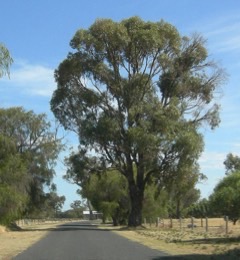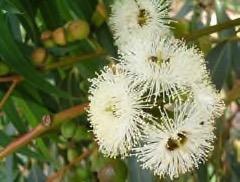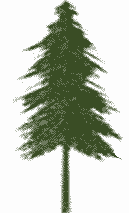 |
|
Wikimedia Commons. |
 |
| Ilena from Wikimedia Commons. |
Translate this page:
Summary
One of the six forest giants of the south Western Australia including: Corymbia calophylla (Marri), Eucalyptus diversicolor (Karri), Eucaltptus jacksonii (Red Tingle), Eucalyptus marinata (Jarrah),Eucalyptus patens (Yarri). A durable hardwood for scantlings, structural timber, the construction of railway carriages, boat building, and furniture manufacture. Due to over-logging the Tuart is a protected tree with conditions placed on felling. A good carbon farming plant as an industrial biomass crop.
Physical Characteristics

 Eucalyptus gomphocephala is an evergreen Tree growing to 40 m (131ft) by 25 m (82ft) at a fast rate.
Eucalyptus gomphocephala is an evergreen Tree growing to 40 m (131ft) by 25 m (82ft) at a fast rate.
See above for USDA hardiness. It is hardy to UK zone 10.
Suitable for: light (sandy), medium (loamy) and heavy (clay) soils, prefers well-drained soil and can grow in nutritionally poor soil. Suitable pH: mildly acid, neutral and basic (mildly alkaline) soils and can grow in saline soils.
It cannot grow in the shade. It prefers dry or moist soil and can tolerate drought.
UK Hardiness Map
US Hardiness Map
Synonyms
Eucalyptus gomphocephala var. rhodoxylon Blakely & H.Steedman
Plant Habitats
Edible Uses
References More on Edible Uses
Medicinal Uses
Plants For A Future can not take any responsibility for any adverse effects from the use of plants. Always seek advice from a professional before using a plant medicinally.
None Known
References More on Medicinal Uses
The Bookshop: Edible Plant Books
Our Latest books on Perennial Plants For Food Forests and Permaculture Gardens in paperback or digital formats.

Edible Tropical Plants
Food Forest Plants for Hotter Conditions: 250+ Plants For Tropical Food Forests & Permaculture Gardens.
More

Edible Temperate Plants
Plants for Your Food Forest: 500 Plants for Temperate Food Forests & Permaculture Gardens.
More

More Books
PFAF have eight books available in paperback and digital formats. Browse the shop for more information.
Shop Now
Other Uses
A durable hardwood for scantlings, structural timber, the construction of railway carriages, and boat building. Also furniture making. The green wood has a density of 1,250 kilograms per cubic metre (78 lb/cu ft) and an air-dried density of 1,030 kilograms per cubic metre (64 lb/cu ft). Flowers good for honey. Carbon Farming Solutions - Industrial Crop: biomass (Crops grown for non-food uses. Industrial crops provide resources in three main categories: materials, chemicals, and energy. Traditional materials include lumber and thatch, paper and cardboard, and textiles) [1-1]. Other Systems: SRC.
Special Uses
Carbon Farming
References More on Other Uses
Cultivation details
Industrial Crop: Biomass Management: Coppice Management: Standard Other Systems: SRC
Climate: Mediterranean, subtropical to tropical, tropical highlands. Humidity: humid. Prefers sandy well drained soils, often over limestone, in sunny positions. Moderately tolerant of saline soil and salt-laden winds. Drought and frost tolerant. Individual trees may live over four hundred years. Carbon Farming Solutions - Cultivation: minor global crop. Management: standard, coppice (Describes the non-destructive management systems that are used in cultivation) [1-1].
Carbon Farming
-
Industrial Crop: Biomass
Three broad categories: bamboos, resprouting woody plants, and giant grasses. uses include: protein, materials (paper, building materials, fibers, biochar etc.), chemicals (biobased chemicals), energy - biofuels
-
Management: Coppice
Cut to the ground repeatedly - resprouting vigorously. Non-destructive management systems maintaining the soil organic carbon.
-
Management: Standard
Plants grow to their standard height. Harvest fruit, seeds, or other products. Non-Destructive management systems.
-
Other Systems: SRC
Short-rotation coppice.
References Carbon Farming Information and Carbon Sequestration Information
Temperature Converter
Type a value in the Celsius field to convert the value to Fahrenheit:
Fahrenheit:
The PFAF Bookshop
Plants For A Future have a number of books available in paperback and digital form. Book titles include Edible Plants, Edible Perennials, Edible Trees,Edible Shrubs, Woodland Gardening, and Temperate Food Forest Plants. Our new book is Food Forest Plants For Hotter Conditions (Tropical and Sub-Tropical).
Shop Now
Plant Propagation
Seeds are first planted in a nursery, then transplanted after 6-10 weeks. For rapid growth the area must be free of weeds.
Other Names
If available other names are mentioned here
Tuart. Tuart Gum
Native Range
AUSTRALASIA: Australia (Western Australia (southwest))
Weed Potential
Right plant wrong place. We are currently updating this section.
Please note that a plant may be invasive in one area but may not in your area so it's worth checking.
None Known
Conservation Status
IUCN Red List of Threatened Plants Status : This taxon has not yet been assessed

| Related Plants
|
| Latin Name | Common Name | Habit | Height | Hardiness | Growth | Soil | Shade | Moisture | Edible | Medicinal | Other |
| Corymbia citriodora | Lemon-Scented Gum, blue spotted gum, lemon eucalyptus, eucalyptus citriodora. | Tree | 45.0 |
10-12
| F | LMH | N | M | 2 | 3 | 4 |
| Eucalyptus brassiana | Cape York red gum | Tree | 20.0 |
9-11
| F | LMH | N | DM | 0 | 0 | 4 |
| Eucalyptus caesia | Gungurru | Tree | 10.0 |
8-11
| F | LMH | N | DMWe | 2 | 0 | |
| Eucalyptus camaldulensis | Red River Gum, Murray Red Gum, River Red Eucalyptus | Tree | 30.0 |
8-12
| F | LMH | N | DMWe | 1 | 3 | 4 |
| Eucalyptus citriodora | Lemon-Scented Gum, Lemon Scented Eucalyptus | Tree | 45.0 |
9-11
| F | LMH | N | DMWe | 1 | 3 | 2 |
| Eucalyptus coccifera | Mt. Wellington Peppermint | Tree | 15.0 |
7-10
| F | LMH | N | DMWe | 0 | 0 | 2 |
| Eucalyptus delegatensis | Alpine ash | Tree | 40.0 |
7-11
| F | LMH | N | M | 0 | 3 | 3 |
| Eucalyptus dumosa | Water Mallee | Tree | 7.0 |
9-11
| F | LMH | N | DMWe | 1 | 0 | 2 |
| Eucalyptus globulus | Tasmanian Blue Gum, Eurabbie, Blue Gum, Blue Eucalyptus | Tree | 55.0 |
9-11
| F | LMH | N | DMWe | 1 | 4 | 3 |
| Eucalyptus grandis | Flooded Gum, Gum, Rose Eucalyptus | Tree | 50.0 |
9-11
| F | LMH | SN | DM | 0 | 2 | 4 |
| Eucalyptus gummifera | Red Bloodwood | Tree | 15.0 |
9-11
| F | LMH | N | DMWe | 1 | 3 | 2 |
| Eucalyptus gunnii | Cider Gum | Tree | 30.0 |
7-10
| F | LMH | N | DMWe | 3 | 3 | 3 |
| Eucalyptus johnstonii | Yellow Gum, Johnston's gum | Tree | 60.0 |
7-10
| F | LMH | N | DMWe | 0 | 0 | 3 |
| Eucalyptus largiflorens | Black Box | Tree | 18.0 |
9-11
| S | LMH | N | DMWe | 1 | 0 | 3 |
| Eucalyptus leucoxylon | Yellow Gum, White ironbark, White Eucalyptus | Tree | 15.0 |
10-11
| F | LMH | N | DMWe | 1 | 0 | 3 |
| Eucalyptus macrorhyncha | Red Stringybark | Tree | 45.0 |
9-11
| F | LMH | N | DMWe | 1 | 3 | 3 |
| Eucalyptus melliodora | Yellow Box | Tree | 30.0 |
9-11
| F | LMH | N | DMWe | 0 | 0 | 3 |
| Eucalyptus microcorys | Tallow Wood, Australian tallowwood | Tree | 45.0 |
9-11
| F | LMH | N | DMWe | 0 | 0 | 3 |
| Eucalyptus microtheca | Coolabah, Coolibah, Flooded Box, Coolibah | Tree | 15.0 |
9-12
| F | LMH | N | M | 2 | 0 | 2 |
| Eucalyptus obliqua | Messmate | Tree | 60.0 |
8-12
| F | LMH | N | DMWe | 0 | 0 | 4 |
| Eucalyptus pauciflora | Cabbage Gum, Snow gum | Tree | 12.0 |
7-10
| F | LMH | N | DMWe | 0 | 0 | 3 |
| Eucalyptus pauciflora niphophila | Snow Gum | Tree | 6.0 |
6-9
| F | LMH | N | DMWe | 0 | 3 | 3 |
| Eucalyptus perriniana | Spinning Gum | Tree | 6.0 |
7-10
| F | LMH | N | DMWe | 0 | 0 | 2 |
| Eucalyptus piperita | Sydney Peppermint | Tree | 18.0 |
9-11
| F | LMH | N | DMWe | 0 | 2 | 3 |
| Eucalyptus polybractea | Blue Mallee | Tree | 6.0 |
-
| F | LMH | N | DMWe | 1 | 3 | 3 |
| Eucalyptus punctata | Grey Gum | Tree | 30.0 |
8-11
| F | LMH | N | DMWe | 1 | 0 | |
| Eucalyptus racemosa | Snappy Gum | Tree | 0.0 |
-
| F | LMH | N | DMWe | 0 | 3 | |
| Eucalyptus regnans | Mountain Ash | Tree | 75.0 |
8-11
| F | LMH | N | DMWe | 0 | 0 | 3 |
| Eucalyptus robusta | Swamp Mahogany, Eucalyptus Gum | Tree | 30.0 |
8-12
| F | LMH | SN | DM | 0 | 3 | 4 |
|
|
Growth: S = slow M = medium F = fast. Soil: L = light (sandy) M = medium H = heavy (clay). pH: A = acid N = neutral B = basic (alkaline). Shade: F = full shade S = semi-shade N = no shade. Moisture: D = dry M = Moist We = wet Wa = water.
Now available:
Food Forest Plants for Mediterranean Conditions
350+ Perennial Plants For Mediterranean and Drier Food Forests and Permaculture Gardens.
[Paperback and eBook]
This is the third in Plants For A Future's series of plant guides for food forests tailored to
specific climate zones. Following volumes on temperate and tropical ecosystems, this book focuses
on species suited to Mediterranean conditions—regions with hot, dry summers and cool, wet winters,
often facing the added challenge of climate change.
Read More
Expert comment
Author
A.Cunn. ex DC.
Botanical References
Links / References
For a list of references used on this page please go here
Readers comment
| Add a comment |
|
If you have important information about this plant that may help other users please add a comment or link below. Only comments or links that are felt to be directly relevant to a plant will be included. If you think a comment/link or information contained on this page is inaccurate or misleading we would welcome your feedback at [email protected]. If you have questions about a plant please use the Forum on this website as we do not have the resources to answer questions ourselves.
* Please note: the comments by website users are not necessarily those held by PFAF and may give misleading or inaccurate information.
To leave a comment please Register or login here All comments need to be approved so will not appear immediately.
|
Subject : Eucalyptus gomphocephala
|
|
|
|